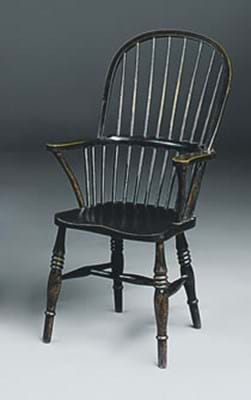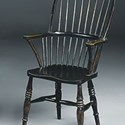However, the very essence of the vernacular seat furniture that makes up the Cotton collection is that it comprises pieces that were in everyday use. Accordingly any auction of oak and vernacular furniture will have some examples of regional chairs.
Simon Green, specialist at Christie's South Kensington where they hold three such sales per year, reckons that on average they feature a couple of stamped pieces per auction.
There are two stamped entries in their sale on March 1. Both are pairs of Windsor chairs, one from Nottinghamshire, the other from the South West. The Nottinghamshire pair (one shown left) is one of a pair in yew and elm which are stamped Nicholson Rockley for George Nicholson c.1830-50.
They have the characteristic North Eastern feature - pencil point tapered ends to the back bow at its junction with the sides. At CSK they are estimated at £3000-4000.
The West Country pair, one pictured right, is stamped T. Miles Bedminster and S Pring, for the Bristol workshop proprietor and chairmaker respectively and, like most West Country chairs, they are painted (black in this instance). They are part of a set of eight made for the library of the Bristol School of the Blind c.1920 and carry an estimate of £700-1000.
Six others are in the Cotton collection, the only known set of maker-provenanced West Country painted Windsor chairs so far recorded Apart from stamped models, there a number of other vernacular examples in the auction that, thanks to all Dr Cotton's researches, can be now be tied to specific regions.
Cases in point include a mid 19th century straw-seated ash ladder back of Kerry type and a yew and elm comb back Windsor of particularly generous proportions with ornate splat and front cabrioles of a type associated with a known group made in the Thames Valley in the late 18th century.








